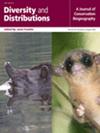No Sign of Homogenisation in Reef Fish Communities Across an Ecological Transition Zone Exposed to Warming
Abstract
Aim
Marine organisms are responding to warming by altering their distribution ranges, causing biogeographic range shifts and in some cases, favouring the community homogenisation. Transition zones can act as natural laboratories to explore the consequences of homogenisation. However, these habitats are relatively poorly studied in coastal areas. In this study, we aimed to investigate biotic homogenisation and changes in reef fish community composition from both a taxonomic and trait-based perspective.
Location
Seven islands in the South-western Atlantic transition zone.
Methods
We used a long-term survey data set of reef fish species abundances and traits of communities to calculate beta-diversity indices. By analysing the data, we derived temporal trends of beta-diversity values by separately comparing the North and South regions of the transition zone and performed pairwise comparisons to explore their dynamics when considered together.
Results
Contrary to previous expectations, we found no sign of homogenisation. The colder islands (Southern) experienced a decrease in taxonomic and trait richness metrics, whereas for the warmer islands (Northern), the taxonomic and trait richness fluctuated without any significant temporal trends.
Main Conclusions
While taxonomic composition may change over time, the trait composition is generally more conserved, highlighting the trait redundancy in South-western Atlantic communities and supporting the idea that these communities can maintain a range of ecological processes despite changes in taxonomic composition. Finally, the study revealed that despite non-homogenisation, the species that contribute most to variation, especially in the South, have common trait combinations indicating an increase in the trait redundancy of fish communities over time. We underline that local-scale conservation efforts may be particularly effective in preserving and protecting species and ecological functions in areas experiencing unique and fast changes in biodiversity.


 求助内容:
求助内容: 应助结果提醒方式:
应助结果提醒方式:


